Aerial refueling
This article has multiple issues.Please helpimprove itor discuss these issues on thetalk page.(Learn how and when to remove these template messages)
|
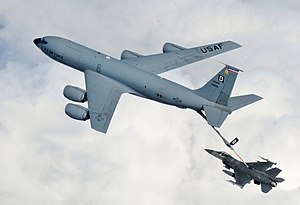
Aerial refueling(en-us), oraerial refuelling(en-gb), also referred to asair refueling,in-flight refueling(IFR),air-to-air refueling(AAR), andtanking,is the process of transferringaviation fuelfrom one aircraft (thetanker) to another (the receiver) while both aircraft are in flight.[a]The two main refueling systems areprobe-and-drogue,which is simpler to adapt to existing aircraft and theflying boom,which offers faster fuel transfer, but requires a dedicatedboom operatorstation.
The procedure allows the receiving aircraft to remain airborne longer, extending its range orloitertime. A series of air refuelings can give range limited only by crewfatigue/physical needs and engineering factors such as engine oil consumption. Because the receiver aircraft is topped-off with extra fuel in the air, air refueling can allow atakeoffwith a greaterpayloadwhich could be weapons, cargo, or personnel: themaximum takeoff weightis maintained by carrying less fuel and topping up once airborne. Aerial refueling has also been considered as a means to reduce fuel consumption on long-distance flights greater than 3,000 nautical miles (5,600 km; 3,500 mi). Potential fuel savings in the range of 35–40% have been estimated for long-haul flights (including the fuel used during the tanker missions).[1]
Usually, the aircraft providing the fuel is specially designed for the task, although refueling pods may be fitted to existing aircraft designs in the case of "probe-and-drogue" systems. The cost of the refueling equipment on both tanker and receiver aircraft and the specialized aircraft handling of the aircraft to be refueled (very close "line astern" formation flying) has resulted in the activity only being used inmilitary operations;there are no regular civilian in-flight refueling activities. Originally trialed shortly beforeWorld War IIon a limited scale to extend the range of British civiliantransatlanticflying boats,and then employed after World War II on a large scale to extend the range ofstrategic bombers,aerial refueling since theVietnam Warhas been extensively used in large-scale military operations.
Development history
[edit]Early experiments
[edit]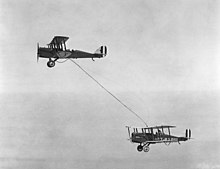
Some of the earliest experiments in aerial refueling took place in the 1920s; two slow-flying aircraft flew in formation, with a hose run down from a hand-held fuel tank on one aircraft and placed into the usual fuel filler of the other. The first mid-air refueling, based on the development ofAlexander P. de Seversky,between two planes occurred on 25 June 1923, between twoAirco DH-4Bbiplanesof theUnited States Army Air Service.An endurance record was set by three DH-4Bs (a receiver and two tankers) on 27–28 August 1923, in which the receiver airplane remained aloft for more than 37 hours using nine mid-air refueling to transfer 687 US gallons (2,600 L) ofaviation gasolineand 38 US gallons (140 L) of engine oil. The same crews demonstrated the utility of the technique on 25 October 1923, when a DH-4 flew fromSumas, Washington,on theCanada–United States border,toTijuana, Mexico,landing inSan Diego,using mid-air refuelings atEugene, Oregon,andSacramento, California.
Similar trial demonstrations of mid-air refueling technique took place at theRoyal Aircraft EstablishmentinEnglandand by theArmée de l'AirinFrancein the same year, but these early experiments were not yet regarded as a practical proposition, and were generally dismissed as stunts.
As the 1920s progressed, greater numbers of aviation enthusiasts vied to set new aerial long-distance records, using inflight air refueling. One such enthusiast, who would revolutionize aerial refueling was SirAlan Cobham,member of theRoyal Flying CorpsinWorld War I,and a pioneer of long-distance aviation. During the 1920s, he made long-distance flights to places as far afield asAfricaandAustraliaand he began experimenting with the possibilities of in-flight refueling to extend the range of flight.[2]
Cobham was one of the founding directors ofAirspeed Limited,an aircraft manufacturing company that went on to produce a specially-adaptedAirspeed Courierthat Cobham used for his early experiments with in-flight refueling. This craft was eventually modified by Airspeed to Cobham's specification, for a non-stop flight fromLondontoIndia,using in-flight refueling to extend the plane's flight duration.
Meanwhile, in 1929, a group ofUS Army Air Corpsfliers, led by then MajorCarl Spaatz,set an endurance record of over 150 hours with a Fokker C-2A named theQuestion Markover Los Angeles. Between 11 June and 4 July 1930, the brothers John, Kenneth, Albert, and Walter Hunter set a new record of 553 hours 40 minutes overChicagousing twoStinson SM-1 Detroitersas refueler and receiver. Aerial refueling remained a very dangerous process until 1935, when brothersFred and Al Keydemonstrated a spill-free refueling nozzle, designed byA. D. Hunter.[3]They exceeded the Hunters' record by nearly 100 hours in aCurtiss Robinmonoplane,[4]staying aloft for more than 27 days.[5]
The US was mainly concerned about transatlantic flights for faster postal service between Europe and America. In 1931 W. Irving Glover, the second assistant postmaster, wrote an extensive article forPopular Mechanicsconcerning the challenges and the need for such a regular service. In his article he even mentioned the use of aerial refueling after takeoff as a possible solution.[6]
AtLe Bourget Airportnear Paris, theAéro-Club de Franceand the 34th Aviation Regiment of theFrench Air Forcewere able to demonstrate passing fuel between machines at the annual aviation fete atVincennesin 1928.[7]The UK'sRoyal Aircraft Establishmentwas also running mid-air refueling trials, with the aim to use this technique to extend the range of the long-distanceflying boatsthat serviced theBritish Empire.By 1931 they had demonstrated refueling between twoVickers Virginias,with fuel flow controlled by an automatic valve on the hose which would cut off if contact was lost.[8]
Royal Air ForceofficerRichard Atcherleyhad observed the dangerous aerial-refueling techniques in use atbarnstormingevents in the US and determined to create a workable system.[9]While posted to theMiddle Easthe developed and patented his 'crossover' system in 1934, in which the tanker trailed a large hooked line that would reel in a similar dropped line from the receiver, allowing the refueling to commence. In 1935, Cobham sold off the airline Cobham Air Routes Ltd toOlley Air Serviceand turned to the development of inflight refueling, founding the companyFlight Refuelling Ltd.Atcherly's system was bought up by Cobham's company, and with some refinement and continuous improvement through the late '30s, it became the first practical refueling system.[10]
Grappled-line looped-hose
[edit]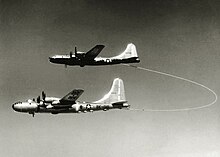
SirAlan Cobham'sgrappled-line looped-hoseair-to-air refueling system borrowed from techniques patented by David Nicolson and John Lord, and was publicly demonstrated for the first time in 1935. In the system the receiver aircraft, at one time anAirspeed Courier,trailed a steel cable which was then grappled by a line shot from the tanker, aHandley Page Type W10.The line was then drawn back into the tanker where the receiver's cable was connected to the refueling hose. The receiver could then haul back in its cable bringing the hose to it. Once the hose was connected, the tanker climbed sufficiently above the receiver aircraft to allow the fuel to flow under gravity.[11][12]
When Cobham was developing his system, he saw the need as purely for long-range transoceanic commercial aircraft flights,[13]but modern aerial refueling is used exclusively by military aircraft.
In 1934, Cobham had foundedFlight Refuelling Ltd(FRL) and by 1938 had used itslooped-hosesystem to refuel aircraft as large as theShort Empireflying boatCambriafrom anArmstrong Whitworth AW.23.[5]Handley Page Harrowswere used in the 1939 trials to perform aerial refueling of the Empire flying boats for regular transatlantic crossings. From 5 August to 1 October 1939, sixteen crossings of the Atlantic were made by Empire flying boats, with fifteen crossings using FRL's aerial refueling system.[14]After the sixteen crossings further trials were suspended due to the outbreak of World War II.[15]
During the closing months of World War II, it had been intended thatTiger Force'sLancasterandLincolnbombers would be in-flight refueled by convertedHalifaxtanker aircraft, fitted with the FRL's looped-hose units, in operations against theJapanese homelands,but the war ended before the aircraft could be deployed. After the war ended, the USAF bought a small number of FRL looped-hose units and fitted a number of B-29s as tankers to refuel specially equipped B-29s and later B-50s. The USAF made only one major change in the system used by the RAF. The USAF version had auto-coupling of the refueling nozzle, where the leader line with the refueling hose is pulled to the receiver aircraft and a refueling receptacle on the belly of the aircraft, allowing high-altitude air-to-air refueling and doing away with the aircraft having to fly to a lower altitude to be depressurized so a crew member could manually do the coupling.[16]
This air-to-air refueling system was used by theB-50 SuperfortressLucky Lady IIof the 43rd Bomb Wing to make its famous first non-stop around-the-world flight in 1949.[17][18]From 26 February to 3 March 1949,Lucky Lady IIflew non-stop around the world in 94 hours and 1 minute, a feat made possible by four aerial refuelings from four pairs ofKB-29Mtankers of the 43d ARS. Before the mission, crews of the 43rd had experienced only a single operational air refueling contact. The flight started and ended atCarswell Air Force BaseinFort Worth, Texaswith the refuelings accomplished overthe Azores,Saudi Arabia,the Pacific Ocean nearGuam,and betweenHawaiiand theWest Coast.[19]
Probe-and-drogue system
[edit]Cobham's company FRL soon realized that their looped-hose system left much to be desired and began work on an improved system that is now commonly called theprobe-and-drogueair-to-air refueling system and today is one of the two systems chosen by air forces for air-to-air refueling, the other being the flying-boom system. In post-war trials the RAF used a modified Lancaster tanker employing the much improved probe-and-drogue system, with a modifiedGloster Meteor F.3jet fighter,serialEE397,fitted with a nose-mounted probe.[20][21]On 7 August 1949, the Meteor flown by FRLtest pilotPat Hornidge took off fromTarrant Rushtonand remained airborne for 12 hours and 3 minutes, receiving 2,352 imperial gallons (10,690 L) of fuel in ten refuelings from a Lancaster tanker. Hornidge flew an overall distance of 3,600 mi (5,800 km), achieving a new jet endurance record.[22][23]FRL still exists as part ofCobham plc.
Modern specializedtankeraircraft have equipment specially designed for the task of offloading fuel to the receiver aircraft, based on drogue and probe, even at the higher speeds modernjet aircrafttypically need to remain airborne.
In January 1948, General Carl Spaazt, then the firstChief of Staffof the newUnited States Air Force,made aerial refueling a top priority of the service. In March 1948, the USAF purchased two sets of FRL's looped-hose in-flight refueling equipment, which had been in practical use withBritish Overseas Airways Corporation(BOAC) since 1946, and manufacturing rights to the system. FRL also provided a year of technical assistance. The sets were immediately installed in twoBoeing B-29 Superfortresses,with plans to equip 80 B-29s.
Flight testing began in May 1948 atWright-Patterson Air Force Base,Ohio,and was so successful that in June orders went out to equip all new B-50s and subsequent bombers with receiving equipment. Two dedicated air refueling units were formed on 30 June 1948: the43d Air Refueling SquadronatDavis-Monthan Air Force Base,Arizona,and the509th Air Refueling SquadronatWalker Air Force Base,New Mexico.The first ARS aircraft used FRL's looped-hose refueling system, but testing with a boom system followed quickly in the autumn of 1948.
The first use of aerial refueling in combat took place during the Korean War, involving F-84 fighter-bombers flying missions from Japanese airfields, due to Chinese-North Korean forces overrunning many of the bases for jet aircraft in South Korea, refueling from converted B-29s using the drogue-and-probe in-flight refueling system with the probe located in one of the F-84's wing-tip fuel tanks.
Systems
[edit]This sectionneeds additional citations forverification.(April 2012) |
Flying boom
[edit]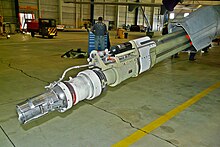
The flying boom is a rigid, telescoping tube with movableflight control surfacesthat aboom operatoron the tanker aircraft extends and inserts into a receptacle on the receiving aircraft. All boom-equipped tankers (e.g.KC-135 Stratotanker,KC-10 Extender,KC-46 Pegasus) have a single boom and can refuel one aircraft at a time with this mechanism.
History
[edit]In the late 1940s, GeneralCurtis LeMay,commander of theStrategic Air Command(SAC), askedBoeingto develop a refueling system that could transfer fuel at a higher rate than had been possible with earlier systems using flexible hoses, resulting in the flying boom system. The B-29 was the first to employ the boom, and between 1950 and 1951, 116 original B-29s, designated KB-29Ps, were converted at the Boeing plant atRenton, Washington.Boeing went on to develop the world's first production aerial tanker, theKC-97 Stratofreighter,a piston-enginedBoeing Stratocruiser(USAF designationC-97 Stratofreighter) with a Boeing-developed flying boom and extra kerosene (jet fuel) tanks feeding the boom. The Stratocruiser airliner itself was developed from the B-29 bomber afterWorld War II.In the KC-97, the mixed gasoline/kerosene fuel system was clearly not desirable and it was obvious that a jet-powered tanker aircraft would be the next development, having a single type of fuel for both its own engines and for passing to receiver aircraft. The 230 mph (370 km/h) cruise speed of the slower, piston-engined KC-97 was also a serious issue, as using it as an aerial tanker forced the newer jet-powered military aircraft to slow down to mate with the tanker's boom, a highly serious issue with the newer supersonic aircraft coming into service at that time, which could force such receiving aircraft in some situations to slow down enough to approach theirstall speedduring the approach to the tanker. It was no surprise that, after the KC-97, Boeing began receiving contracts from the USAF to build jet tankers based on theBoeing 367-80(Dash-80) airframe. The result was theBoeing KC-135 Stratotanker,of which 732 were built.
The flying boom is attached to the rear of the tanker aircraft. The attachment isgimballed,allowing the boom to move with the receiver aircraft. The boom contains a rigid pipe to transfer fuel. The fuel pipe ends in a nozzle with a flexible ball joint. The nozzle mates to the "receptacle" in the receiver aircraft during fuel transfer. Apoppet valvein the end of the nozzle prevents fuel from exiting the tube until the nozzle properly mates with the receiver's refueling receptacle. Once properly mated,togglesin the receptacle engage the nozzle, holding it locked during fuel transfer.
The "flying" boom is so named becauseflight control surfaces,small movableairfoilsthat are often in aV-tailconfiguration, are used to move the boom by creating aerodynamic forces. They are actuatedhydraulicallyand controlled by theboom operatorusing a control stick. The boom operator also telescopes the boom to make the connection with the receiver's receptacle.
To complete an aerial refueling, the tanker and receiver aircraft rendezvous, flying in formation. The receiver moves to a position behind the tanker, within safe limits of travel for the boom, aided by director lights or directions radioed by the boom operator. Once in position, the operator extends the boom to make contact with the receiver aircraft. Once in contact, fuel is pumped through the boom into the receiver aircraft.
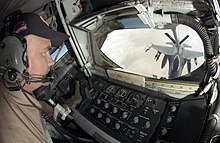
While in contact, the receiver pilot must continue to fly within the "air refueling envelope", the area in which contact with the boom is safe. Moving outside of this envelope can damage the boom or lead to mid-air collision, for example the1966 Palomares B-52 crash.If the receiving aircraft approaches the outer limits of the envelope, the boom operator will command the receiver pilot to correct their position and disconnect the boom if necessary.
When the desired amount of fuel has been transferred, the two aircraft disconnect and the receiver aircraft departs the formation. When not in use, the boom is stored flush with the bottom of the tanker's fuselage to minimize drag.
In the KC-97 and KC-135 the boom operator lies prone, while the operator is seated in theKC-10,all viewing operations through a window at the tail. TheKC-46seats two operators at the front of the aircraft viewing camera video on 3D screens.
The US Air Force fixed-wing aircraft use the flying boom system, along with countries operating F-16 or F-15 variants. The system is used by Australia (KC-30A), the Netherlands (KDC-10), Israel (modified Boeing 707), Japan (KC-767), Turkey (KC-135Rs), and Iran (Boeing 747). The system allows higher fuel flow rates (up to 1,000 US gallons (3,800 L) / 6,500 pounds (2,900 kg) per minute for the KC-135, but does require a boom operator, and can only refuel one aircraft at a time.
Probe-and-drogue
[edit]
The probe-and-drogue refueling method employs a flexible hose that trails from the tanker aircraft. Thedrogue(orpara-drogue), sometimes called abasket,is a fitting resembling ashuttlecock,attached at its narrow end (like the "cork" nose of a shuttlecock) with a valve to a flexible hose. The drogue stabilizes the hose in flight and provides a funnel to aid insertion of the receiver aircraft probe into the hose. The hose connects to a Hose Drum Unit (HDU). When not in use, the hose/drogue is reeled completely into the HDU.
The receiver has aprobe,which is a rigid, protruding or pivoted retractable arm placed on the aircraft's nose or fuselage to make the connection. Most modern versions of the probe are usually designed to be retractable, and are retracted when not in use, particularly on high-speed aircraft.[citation needed]
At the end of the probe is a valve that is closed until it mates with the drogue's forward internal receptacle, after which it opens and allows fuel to pass from tanker to receiver. The valves in the probe and drogue that are most commonly used are to aNATOstandard and were originally developed by the companyFlight Refuelling Limitedin the UK and deployed in the late 1940s and 1950s.[citation needed]This standardization enables drogue-equipped tanker aircraft from many nations to refuel probe-equipped aircraft from other nations.
The NATO-standard probe system incorporates shear rivets that attach the refueling valve to the end of the probe.[citation needed]This is so that if a large side or vertical load develops while in contact with the drogue, the rivets shear and the fuel valve breaks off, rather than the probe or receiver aircraft suffering structural damage. A so-called "broken probe" (actually a broken fuel valve, as described above) may happen if poor flying technique is used by the receiver pilot, or in turbulence. Sometimes the valve is retained in the tanker drogue and prevents further refueling from that drogue until removed during ground maintenance.
Buddy store
[edit]
A "buddy store" or "buddy pod" is an external pod loaded on an aircrafthardpointthat contains a hose and drogue system (HDU).[24]Buddy stores allow fighter / bomber aircraft to be reconfigured for "buddy tanking" other aircraft. This allows an air combat force without dedicated/specialized tanker support (for instance, acarrier air wing) to extend the range of its strike aircraft. In other cases, using the buddy store method allows acarrier-based aircraft to take-off with a heavier than usual load less fuel than might be necessary for its tasking. The aircraft would then topped-up with fuel from an HDU-equipped "buddy" tanker, a method previously used by theRoyal Navyin operating itsSupermarine Scimitar,de Havilland Sea Vixen,andBlackburn Buccaneers;in the Buccaneer's case using a bomb-bay-mounted tank and HDU.

The tanker aircraft flies straight and level and extends the hose/drogue, which is allowed to trail out behind and below the tanker under normal aerodynamic forces. The pilot of the receiver aircraft extends the probe (if required) and uses normal flight controls to "fly" the refueling probe directly into the basket. This requires a closure rate of about two knots (walking speed) to push the hose several feet into the HDU and solidly couple the probe and drogue. Too little closure will cause an incomplete connection and no fuel flow (or occasionally leaking fuel). Too much closure is dangerous because it can trigger a strong transverseoscillationin the hose, severing the probe tip.
The optimal approach is from behind and below (not level with) the drogue. Because the drogue is relatively light (typically soft canvas webbing) and subject to aerodynamic forces, it can be pushed around by the bow wave of approaching aircraft, exacerbating engagement even in smooth air. After initial contact, the hose and drogue is pushed forward by the receiver a certain distance (typically, a few feet), and the hose is reeled slowly back onto its drum in the HDU. This opens the tanker's main refueling valve allowing fuel to flow to the drogue under the appropriate pressure (assuming the tanker crew has energized the pump). Tension on the hose is aerodynamically 'balanced' by a motor in the HDU so that as the receiver aircraft moves fore and aft, the hose retracts and extends, thus preventing bends in the hose that would cause undue side loads on the probe. Fuel flow is typically indicated by illumination of a green light near the HDU. If the hose is pushed in too far or not far enough, a cutoff switch will inhibit fuel flow, which is typically accompanied by an amber light. Disengagement is commanded by the tanker pilot with a red light.[24]
TheUS Navy,Marine Corps,and someArmyaircraft refuel using the "hose-and-drogue" system, as do most aircraft flown by western European militaries. TheSoviet Unionalso used a hose-and-drogue system, dubbed UPAZ,[25]and thus later Russian aircraft may be equipped with probe and drogue. The Chinese PLAF has a fleet ofXian H-6bombers modified for aerial refueling, and plans to add RussianIlyushin Il-78aerial refueling tankers.[26] Tankers can be equipped with multipoint hose-and-drogue systems, allowing them to refuel two (or more) aircraft simultaneously, reducing time spent refueling by as much as 75% for a four-aircraft strike package.[27]
Boom drogue adapter units
[edit]
USAF KC-135 andFrench Air ForceKC-135FR refueling-boom equipped tankers can be field-converted to a probe-and-drogue system using a special adapter unit. In this configuration, the tanker retains its articulated boom, but has a hose/drogue at the end of it instead of the usual nozzle. The tanker boom operator holds the boom still while the receiver aircraft flies the probe into the basket. Unlike the soft canvas basket used in most drogue systems, the adapter units use a steel basket, grimly known as the "iron maiden" bynaval aviatorsbecause of its unforgiving nature. Soft drogues can be contacted slightly off center, wherein the probe is guided into the hose receptacle by the canvas drogue. The metal drogue, when contacted even slightly off center, will pivot out of place, potentially "slapping" the aircraft's fuselage and causing damage.
The other major difference with this system is that when contacted, the hose does not "retract" into an HDU. Instead, the hose bends depending on how far it is pushed toward the boom. If it is pushed too far, it can loop around the probe or nose of the aircraft, damage the windscreen, or cause contact with the rigid boom. If not pushed far enough, the probe will disengage, halting fueling. Because of a much smaller position-keeping tolerance, staying properly connected to a KC-135 adapter unit is considerably more difficult than staying in a traditional hose/drogue configuration. When fueling is complete, the receiver carefully backs off until the probe refueling valve disconnects from the valve in the basket. Off center disengagements, like engagements, can cause the drogue to "prang" the probe and/or strike the aircraft's fuselage.
Multiple systems
[edit]
Some tankers have both a boom and one or more complete hose-and-drogue systems. The USAFKC-10has both a flying boom and a separate hose-and-drogue system manufactured byCobham.Both are on the aircraft centerline at the tail of the aircraft, so only one can be used at once. However, such a system allows all types of probe- and receptacle-equipped aircraft to be refueled in a single mission, without landing to install an adapter. Other tankers are equipped with hose-and-drogue attachments that do not interfere with the operation of the centerline boom: manyKC-135sare equipped with dual under-wing attachments known asMulti-point Refueling System(MPRSs), while some KC-10s andA330 MRTTshave similar under-wing refueling pods (referred to as Wing Air Refueling Pods or WARPs on the KC-10).
Wing-to-wing
[edit]A small number of SovietTu-4sandTu-16s(the tanker variant was Tu-16Z). used a wing-to-wing method. Similar to the probe-and-drogue method but more complicated, the tanker aircraft released a flexible hose from its wingtip. An aircraft flying alongside had to catch the hose with a special lock under its wingtip. After the hose was locked and the connection was established, the fuel was pumped.[28]
Simple grappling
[edit]Some historic systems used for pioneering aerial refueling used the grappling method, where the tanker aircraft unreeled the fuel hose and the receiver aircraft would grapple the hose midair, reel it in and connect it so that fuel can be transferred either with the assistance of pumps or simply bygravity feed.This was the method used on theQuestion Markendurance flight in 1929.
Compatibility issues
[edit]The probe-and-drogue system is not compatible with flying boom equipment, creating a problem for military planners where mixed forces are involved.[29]Incompatibility can also complicate the procurement of new systems. The Royal Canadian Air Force currently wish to purchase theF-35A,which can only refuel via the flying boom, but only possessprobe-and-drogue refuelers.The potential cost of converting F-35As to probe-and-drogue refueling (as is used on US Navy & Marine CorpsF-35BsandF-35Cs) added to the early-2010s political controversy which surrounded F-35 procurement within the RCAF.[30][needs update]
These concerns can be addressed by drogue adapters (see section "Boom drogue adapter units" above) that allow drogue aircraft to refuel from boom-equipped aircraft, and by refuelers that are equipped with both drogue and boom units and can thus refuel both types in the same flight, such as the KC-10, MPRS KC-135, or Airbus A330 MRTT.
Strategic
[edit]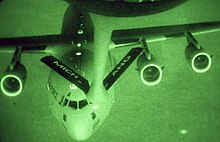
The development of theKC-97andBoeing KC-135 Stratotankerswas pushed by theCold Warrequirement of the United States to be able to keep fleets ofnuclear-armedB-47 StratojetandB-52 Stratofortressstrategic bombersairborne around-the-clock either to threaten retaliation against aSovietstrike formutual assured destruction,or to bomb the USSR first had it been ordered to do so. The bombers would fly orbits around their assigned positions from which they were to enter Soviet airspace if they received the order, and the tankers would refill the bombers' fuel tanks so that they could keep a force in the air 24 hours a day, and still have enough fuel to reach their targets in the Soviet Union. This also ensured that afirst strikeagainst the bombers' airfields could not obliterate the US's ability to retaliate by bomber.
In 1958, Valiant tankers in the UK were developed with one HDU mounted in the bomb-bay. Valiant tankers of 214 Squadron were used to demonstrate radius of action by refueling a Valiant bomber non-stop from UK to Singapore in 1960 and a Vulcan bomber to Australia in 1961. Other UK exercises involving refueling aircraft from Valiant tankers includedJavelinandLightningfighters, also Vulcan and Victor bombers. For instance, in 1962 a squadron of Javelin air defense aircraft was refueled in stages from the UK toIndiaand back (exercise "Shiksha" ). After the retirement of the Valiant in 1965, the Handley Page Victor took over the UK refueling role and had three hoses (HDUs). These were a fuselage-mounted HDU and a refueling pod on each wing. The center hose could refuel any probe-equipped aircraft, the wing pods could refuel the more maneuverable fighter/ground attack types.
A byproduct of this development effort and the building of large numbers of tankers was that these tankers were also available to refuelcargo aircraft,fighter aircraft,andground attack aircraft,in addition to bombers, for ferrying to distant theaters of operations. This was much used during theVietnam War,when many aircraft could not have covered the transoceanic distances without aerial refueling, even with intermediate bases inHawaiiandOkinawa.In addition to allowing the transport of the aircraft themselves, the cargo aircraft could also carrymatériel,supplies, and personnel to Vietnam without landing to refuel. KC-135s were also frequently used for refueling of air combat missions from air bases in Thailand.
The USAFSR-71 Blackbirdstrategic reconnaissance aircraft made frequent use of air-to-air refueling. Indeed, design considerations of the aircraft made its mission impossible without aerial refueling. Based atBeale AFBin centralCalifornia,SR-71s had to be forward-deployed to Europe and Japan prior to flying actual reconnaissance missions. These trans-Pacific and trans-Atlantic flights during deployment were impossible without aerial refueling. The SR-71's designers traded takeoff performance for better high-speed, high-altitude performance, necessitating takeoff with less-than-full fuel tanks from even the longest runways. Once airborne, the Blackbird would accelerate to supersonic speed using afterburners to facilitate structural heating and expansion. The magnitude of temperature changes experienced by the SR-71, from parked to its maximum speed, resulted in significant expansion of its structural parts in cruise flight. To allow for the expansion, the Blackbird's parts had to fit loosely when cold, so loosely, in fact, that the Blackbird constantly leaked fuel before heating expanded the airframe enough to seal its fuel tanks. Following the supersonic dash the SR-71 would then rendezvous with a tanker to fill its now nearly empty tanks before proceeding on its mission. This was referred to as theLTTR(for "Launch To Tanker Rendezvous" ) profile. LTTR had the added advantage of providing an operational test of the Blackbird's refueling capability within minutes after takeoff, enabling a Return-To-Launch-Site abort capability if necessary. At its most efficient altitude and speed, the Blackbird was capable of flying for many hours without refueling. The SR-71 used a special fuel,JP-7,with a very highflash pointto withstand the extreme skin temperatures generated during Mach 3+ cruise flight.[31]While JP-7 could be used by other aircraft, its burn characteristics posed problems in certain situations (such as high-altitude, emergency engine starts) that made it less than optimal for aircraft other than the SR-71.
Normally, all the fuel aboard a tanker aircraft may be either offloaded, or burned by the tanker as necessary. To make this possible, the KC-135 fuel system incorporated gravity draining and pumps to allow moving fuel from tank to tank depending on mission needs. Mi xing JP-7 with JP-4 or Jet A, however, rendered it unsuitable for use by the SR-71, so the Air Force commissioned a specially modified KC-135 variant, theKC-135Q,which included changes to the fuel system and operating procedures preventing inadvertent inflight mi xing of fuel intended for offload with fuel intended for use by the tanker. SR-71 aircraft were refueled exclusively by KC-135Q tankers.
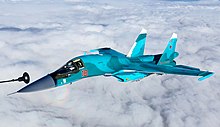
Tactical
[edit]Tankers are considered "force multipliers",because they convey considerable tactical advantages. Primarily, aerial refueling adds to the combat radius of attack, fighter and bombers aircraft, and allows patrol aircraft to remain airborne longer, thereby reducing the number of aircraft necessary to accomplish a given mission. Aerial refueling can also mitigate basing issues that might otherwise place limitations on combatpayload.Combat aircraft operating from airfields with shorter runways must limit their takeoff weight, which could mean a choice between range (fuel) and combat payload (munitions). Aerial refueling, however, eliminates many of these basing difficulties because a combat aircraft can take off with a full combat payload and refuel immediately.
Operational history
[edit]Cold War
[edit]Even as the first practical methods for aerial refueling were being developed, military planners had already envisioned what missions could be greatly enhanced by using such techniques. In the emergingCold Warclimate of the late 1940s, the ability for bombers to perform increasingly long distance missions would enable targets to be struck even from air bases on a different continent. Thus, it became commonplace fornuclear-armedstrategic bombersto be equipped with aerial refueling apparatus and for it to be used to facilitate long distance patrols.[32]
During the late 1950s, aerial refueling had become so prevalent amongst the bombers operated by the US Air Force'sStrategic Air Commandthat many, such as theConvair B-58 Hustler,would operate largely or entirely out of bases in the continental United States while maintaining strategic reach.[32]This practice was promoted to address security concerns as well as diplomatic objections from some overseas nations that did not want foreign nuclear weapons being kept on their soil.[32]In one early demonstration of theBoeing B-52 Stratofortress's global reach, performed between 16 and 18 January 1957, three B-52Bs made anon-stop flightaround the world duringOperation Power Flite,during which 24,325 miles (21,145 nmi, 39,165 km) was covered in 45 hours 19 minutes (536.8 smph) with multiple in-flight refuelings being performed from KC-97s.[33][34]
While development of theAvro Vulcanstrategic bomber was underway, British officials recognised that its operational flexibility could be improved by the provision of in-flight refueling equipment.[35]Accordingly, from the 16th aircraft to be completed onwards, the Vulcan was furnished with in-flight refueling receiving equipment.[36][37]While continuous airborne patrols were flown by the RAF for a time, these were deemed to be untenable, and the refueling mechanisms across the Vulcan fleet largely fell into disuse during the 1960s.[37]When the RAF chose to optimise its bomber fleet away from high-altitude flight and towards low-level penetration missions, bombers such as theHandley Page Victorwere fitted with aerial refueling probes and additional fuel tanks to counter the decreased range from the shift in flight profile.[38][39]
During the mid-1950s, to deliver France's independentnuclear deterrent,work commenced on what would become theDassault Mirage IVsupersonic bomber.[40][41]The dimensions of this bomber was greatly determined by the viability of aerial refueling, with work on an enlarged variant of the Mirage IV ultimately being aborted in favour of a greater reliance upon aerial tanker aircraft instead.[42]In order to refuel the Mirage IVA fleet, France purchased 14 (12 plus 2 spares) US BoeingC-135Ftankers.[40]Mirage IVAs also often operated in pairs, with one aircraft carrying a weapon and the other carrying fuel tanks and a buddy refueling pack, allowing it to refuel its partner en route to the target.[43]While able to strike at numerous targets inside of the Soviet Union, the inability for the Mirage IV to return from some missions had been a point of controversy during the aircraft's design phase.[44][45]
Korean War
[edit]On 6 July 1951, the first combat air refueling of fighter-type aircraft took place over Korea. Three RF-80As launched from Taegu with the modified tip-tanks and rendezvoused with a tanker offshore of Wonsan, North Korea. Through in-flight refueling, the RF-80s effectively doubled their range, which enabled them to photograph valuable targets in North Korea.[46][47]
Vietnam War
[edit]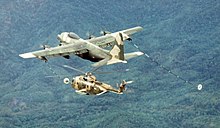
During theVietnam War,it was common for USAF fighter-bombers flying fromThailandtoNorth Vietnamto refuel from KC-135s en route to their target. Besides extending their range, this enabled theF-105sandF-4 Phantomsto carry more bombs and rockets. Tankers were also available for refueling on the way back if necessary. In addition to ferrying aircraft across thePacific Ocean,aerial refueling made it possible for battle-damaged fighters, with heavily leaking fuel tanks, to hook up to the tankers and let the tanker feed its engine(s) until the point where they could glide to the base and land. This saved numerous aircraft.[citation needed]
The US Navy frequently used carrier-based aerial tankers like theKA-3 Skywarriorto refuel Navy and Marine aircraft such as the F-4,A-4 Skyhawk,A-6 Intruder,andA-7 Corsair II.This was particularly useful when a pilot returning from an airstrike was having difficulty landing and was running low onjet fuel.This gave them fuel for more attempts at landing for a successful "trap" on an aircraft carrier. The KA-3 could also refuel fighters on extended Combat Air Patrol. USMC jets based in South Vietnam and Thailand also used USMCKC-130 Herculestransports for air-to-air refueling on missions.
During late August 1970, a pair ofHH-53Chelicopters performed the first Trans-Pacific flight by a helicopter, flying fromEglin AFBin Florida toDanangin South Vietnam. In addition to making multiple en route stops to refuel on the ground, aerial refueling was also used in this display of the type's long-range capabilities. The flight proved to be roughly four times faster than the traditional dispatching of rotorcraft to the theatre by ship.[48]
Middle East
[edit]During the 1980sIran–Iraq War,the Iranian Air Force maintained at least one KC 707-3J9C aerial tanker, which the Islamic Republic had inherited from the Shah's government. This was used most effectively on 4 April 1981, refueling eight IRIAF F-4 Phantoms on long-range sorties into Iraq tobomb the H-3 Al Walid airfieldnear the Jordanian border, destroying 27–50 Iraqi fighter jets and bombers.[49][50]However, the Iranian Air Force was forced to cancel its 180-day air offensive and attempts to control Iranianairspacedue to unsustainable rates of attrition.[51][52]
TheIsraeli Air Forcehas a fleet of Boeing 707s equipped with a boom refueling system similar to the KC-135, this system has the Israeli nameRam,used to refuel and extend the range of fighter bombers such as the F-15I and F-16I for deterrent and strike missions, they are nearing 60 years old and Israel does not disclose the number of tankers in their fleet.[53][54][55]In 1985, IsraeliF-15sused heavily modifiedBoeing 707aircraft to provide aerial refueling over theMediterranean Seain order to extend their range forOperation Wooden Leg,an air raid on the headquarters of thePalestine Liberation Organization(PLO) nearTunis,Tunisia,that necessitated a 2,000 km flight.[56]As of 2021 Israel has ordered four of a planned eightBoeing KC-46 Pegasusboom refueling tankers and has requested that the first two aircraft be fast-tracked for delivery in 2022 when they were to be delivered in 2023. The Jerusalem Post reports that Israeli commanders have made this request to enhance the strategic deterrence against Iran, the same article reports that the US, whose air force is also taking its first deliveries of the aircraft type, has refused to move forward the deliveries while supporting Israel's deterrence; the Jpost editor writing "The US State Department approved the possible sale of up to eight KC-46 tanker aircraft and related equipment to Israel for an estimated cost of $2.4 billion last March(i.e. 5/2020), marking the first time that Washington has allowed Jerusalem to buy new tankers."[55]
Falklands War
[edit]During theFalklands War,aerial refueling played a vital role in all of the successful Argentine attacks against theRoyal Navy.TheArgentine Air Forcehad only two KC-130H Hercules available and they were used to refuel both Air Force and NavyA-4 Skyhawksand NavySuper Etendardsin theirExocetstrikes. The Hercules on several occasions approached the islands (where theSea Harrierswere in patrol) to search and guide the A-4s in their returning flights. On one of those flights (callsignJaguar) one of the KC-130s went to rescue a damaged A-4 and delivered 39,000 lb (18,000 kg) of fuel while carrying it to its airfield atSan Julian.However, theMirage IIIsandDaggerslack of air refueling capability prevented them from achieving better results. The Mirages were unable to reach the islands with a strike payload, and the Daggers could do so only for a five-minute strike flight.
On the British side, air refueling was carried out by theHandley Page VictorK.2 and, after the Argentine surrender, by modified C-130 Hercules tankers. These aircraft aided deployments from the UK to theAscension Islandstaging post in the Atlantic and further deployments south of bomber, transport and maritime patrol aircraft.[57]The most famous refueling missions were the 8,000 nmi (15,000 km) "Operation Black Buck"sorties which used 14 Victor tankers to allow anAvro Vulcanbomber (with a flying reserve bomber) to attack the Argentine-captured airfield at Port Stanley on theFalkland Islands.With all the aircraft flying from Ascension, the tankers themselves needed refueling.[58][59][60]The raids were the longest-range bombing raids in history until surpassed by theBoeing B-52sflying from the States to bomb Iraq in the 1991Gulf Warand laterB-2flights.[61]
Gulf War
[edit]During the time of Operation Desert Shield, the military buildup to the Persian Gulf War, US Air Force Boeing KC-135s & McDonnell Douglas KC-10As, and USMC KC-130 Hercules aircraft were deployed to forward air bases inEngland,Diego Garcia,andSaudi Arabia.Aircraft stationed in Saudi Arabia normally maintained an orbit in theSaudi–Iraqi neutral zone,informally known as "Frisbee", and refueled coalition aircraft whenever necessary. Two side by side tracks over central Saudi Arabia called "Prune" and "Raisin" featured 2–4 basket equipped KC-135 tankers each and were used by Navy aircraft from theRed Sea Battle Force.Large Navy strike groups from the Red Sea would send A-6 tankers to the Prune and Raisin tracks ahead of the strike aircraft arriving to top off and take up station to the right of the Air Force tankers thereby providing an additional tanking point. RAF Handley Page Victor andVickers VC10tankers were also used to refuel British and coalition aircraft and were popular with the US Navy for their docile basket behavior and having three point refueling stations. An additional track was maintained close to the northwest border for the E-3 AWACS aircraft and any Navy aircraft needing emergency fuel. These 24-hour air-refueling zones enabled the intense air campaign during Desert Storm. An additional 24/7 tanker presence was maintained over the Red Sea itself to refuel Navy F-14 Tomcats maintainingCombat Air Patroltracks. During the conflict's final week, KC-10s moved inside Iraq to support barrier CAP missions set up to block Iraqi fighters from escaping to Iran.

On 16–17 January 1991, the first combat sortie of Operation Desert Storm, and the longest combat sortie in history at that time, was launched fromBarksdale AFB, Louisiana.Seven B-52Gs flew a thirty-five-hour mission to the region and back to launch 35Boeing Air Launched Cruise Missiles(ALCMs) with the surprise use of conventional warheads. This attack, which successfully destroyed 85–95 percent of intended targets, would have been impossible without the support of refueling tankers.[62][63]
An extremely useful tanker in Desert Storm was the USAF's KC-10A Extender. Besides being larger than the other tankers deployed, the KC-10A is equipped with the USAF "boom" refueling and also the "hose-and-drogue" system, enabling it to refuel not only USAF aircraft, and also USMC and US Navy jets that use the "probe-and-drogue" system, and also allied aircraft, such as those from the UK and Saudi Arabia. KC-135s may be equipped with a drogue depending on the mission profile. With a full jet fuel load, the KC-10A is capable of flying from a base on the American east coast, flying nonstop to Europe, transferring a considerable amount of fuel to other aircraft, and returning to its home base without landing anywhere else.[citation needed]
On 24 January 1991, theIraqi Air Forcelaunched theAttack on Ras Tanura,an attempt to bomb the Ras Tanura oil facility in Saudi Arabia. On their way to the target, the Iraqi attack aircraft were refueled by tanker at an altitude of 100 meters. The attack ultimately failed, with two aircraft turning back and the remaining two shot down.[64][65]
Helicopters
[edit]Helicopter in-flight refueling (HIFR) is a variation of aerial refueling when a navalhelicopterapproaches a warship (not necessarily suited for landing operations) and receives fuel through the cabin while hovering. Alternatively, some helicopters like the HH-60 Pave Hawk are equipped with a probe extending out the front can be refueled from a drogue-equipped tanker aircraft in a similar manner to fixed-wing aircraft by matching a high forward speed for a helicopter to a slow speed for the fixed-wing tanker.
Longest crewed flight record
[edit]A mission modifiedCessna 172 Skyhawkwith a crew of two set the world record for the longest continuous crewed flight without landing of 64 days, 22 hours, 19 minutes, and five seconds in 1958. A Ford truck was outfitted with a fuel pump, tank, and other paraphernalia required to support the aircraft in flight. The publicity flight for a Las Vegas area hotel ended when the aircraft's performance had degraded to the point where the Cessna had difficulty climbing away from the refueling vehicle.[66][67]
Developments
[edit]- Commercial tankers are occasionally used by military forces. TheOmega Aerial Refueling Servicescompany[68]and Metrea Strategic Mobility[69]are contracted by the US Navy. In June 2023, Metrea completed the first commercial refueling of the US Air Force.[70]
- Autonomous (hands off) refuelingusing probe/drogue systems was investigated byNASA,potentially for use byunmanned aerial vehiclesin theKQ-Xprogram.[71]
Operators
[edit]
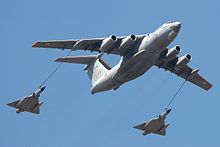

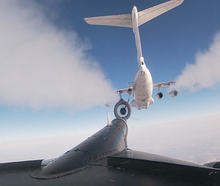

See also
[edit]- Military logistics
- Propellant depot
- Underway replenishment,the transfer of refuel and stores at sea
- List of tanker aircraft
Notes
[edit]- ^"AAR" can also stand forAfter Action Review(i.e. debriefing); "IFR" also stands forInstrument Flight Rules.
References
[edit]Citations
[edit]- ^Nangia, R.K (November 2006)."Operations and aircraft design towards greener civil aviation using air-to-air refuelling"(PDF).The Aeronautical Journal.Paper No. 3088. (November): 705–721.doi:10.1017/S0001924000001585.S2CID114942345.Archived fromthe original(PDF)on 21 October 2013.Retrieved20 October2011.
- ^Colin Cruddas,Highways to the Empire(Air Britain, 2006,ISBN0-85130-376-5); G.H. Pirie,Air Empire: British Imperial Civil Aviation, 1919–39(Manchester University Press, 2009), Chapter 6.ISBN978-0-7190-4111-2;G.H. Pirie,Cultures and Caricatures of British imperial Aviation: Passengers, Pilots, Publicity(Manchester University Press, 2012), Chapter 4.
- ^There is no evidence of a relationship between A.D. Hunter and the Hunter brothers.
- ^"National Air and Space Museum image".Archived fromthe originalon 16 April 2009.
- ^abHistory of Aviation, Part 19, 1938
- ^Hearst Magazines (February 1931)."Wings Across The Atlantic".Popular Mechanics.Hearst Magazines. p. 190.Archivedfrom the original on 13 March 2023.Retrieved4 June2016.
- ^Flight Magazine archive, 10 January 1929
- ^Flight Magazine archive, 3 July 1931, p. 623
- ^Richard K. Smith."Seventy Five Years of Inflight Refueling"(PDF).Archived(PDF)from the original on 24 August 2017.Retrieved1 October2013.
- ^"Mid-air refuelling in Gander".Archivedfrom the original on 24 March 2017.Retrieved4 October2013.
- ^Bonnier Corporation (January 1947)."Gas Station In The Sky".Popular Science.Bonnier Corporation. p. 2.
- ^"Refuelling In Flight",Flight Magazine, November 22, 1945Archived5 October 2013 at theWayback Machineclose-up drawing of receiver pawl grapnel and tanker haul line projectile
- ^"flight march – receiver aircraft – advertisements flight – 1947 – 0392 – Flight Archive".Archivedfrom the original on 2 April 2015.Retrieved19 November2016.
- ^Note – on one flight there was a high westerly wind and no need for aerial refueling
- ^"imperial airways – 1940 – 1219 – Flight Archive".Archivedfrom the original on 5 October 2013.Retrieved19 November2016.
- ^Bonnier Corporation (August 1948)."What Can Our Bombers Do Now?".Popular Science.Bonnier Corporation. p. 79.Archivedfrom the original on 13 March 2023.Retrieved4 June2016.
- ^"flight – lucky lady – flight refuelling – 1949 – 0461 – Flight Archive".Archivedfrom the original on 21 August 2016.Retrieved19 November2016.
- ^"B-50s In Great Britain",Flight magazine, 1 September 1949
- ^Hallex, Steve. "Around the World in 94 Hours*".Logbook.14(1, 1st Quarter 2016).
- ^"Cobham 75:: Air-to-Air Refuelling Takes off".Archived fromthe originalon 8 July 2011.Retrieved17 November2009.
- ^Bonnier Corporation (October 1949)."Jet Refuels Like Humming Bird".Popular Science.Bonnier Corporation. p. 131.Archivedfrom the original on 13 March 2023.Retrieved16 May2019.
- ^"Meteor's 12-hour Flight",Flight,1949,archivedfrom the original on 8 July 2017,retrieved13 April2014
- ^"50 Years of Probe and Drogue Flight Refuelling cover signed Air Chief Marshal Sir Michael Knight KCB AFC FRAES".Archivedfrom the original on 4 March 2016.Retrieved19 November2016.
- ^abNaval Air Systems Command (1 August 2006).A1-F18AC-NFM-000 Naval Aviation Training and Operating Procedures Standardization (NATOPS) Manual.United StatesDepartment of the Navy.p. 364.
- ^"Inflight Refueling".Zvezda JSC.Archived fromthe originalon 16 August 2007.Retrieved6 July2021.
- ^Cordesman & Kleiber 2007,p. 158.
- ^Maj.Marck R. Cobb,"Aerial Refueling: The Need for a Multipoint, Dual-System Capability," AU-ARI-CP-87-3, Air University Press, July 1987.
- ^note – even today there is much confusion about how this system actually worked
- ^Christopher, Bolkcom; D., Klaus, Jon (11 May 2005)."Air Force Aerial Refueling Methods: Flying Boom versus Hose-and-Drogue".Digital Library.Archivedfrom the original on 11 May 2009.Retrieved27 October2017.
{{cite journal}}:CS1 maint: multiple names: authors list (link) - ^"Canadian military unable to refuel new jets in mid-air".Macleans.ca.31 January 2011.Archivedfrom the original on 14 June 2015.Retrieved13 June2015.
- ^"Lockheed SR-71 Blackbird".Archivedfrom the original on 17 March 2010.Retrieved8 February2014.
- ^abcFarley, Robert (10 June 2016)."The B-58 Hustler: America's Cold War Nuclear Bomber Blunder".nationalinterest.org.Archivedfrom the original on 23 April 2021.Retrieved30 March2021.
- ^Condor 1994, p. 42.
- ^Knaack 1988, p. 243.
- ^Wynn 1997, p. 154.
- ^Wynn 1997, p. 155.
- ^abBrookes and Davey 2009, p. 49.
- ^RodwellFlight13 February 1964, p. 241.
- ^Windle and Bowman 2009, p. 21.
- ^abGunston 1973, p. 104.
- ^Gunston and Gilchrist 1993, p. 196.
- ^Gunston 1973, p. 109.
- ^Gunston and Gilchrist 1993, p. 200.
- ^Dumoulin, André,"La dissuasion nucléaire française en posture méditerranéenne"(PDF),Les Cahiers du RMES,II(1): 5–12, archived fromthe original(PDF)on 13 March 2012,retrieved18 October2010,
(p. 5) Certes, la posture méditerranéenne ne pouvait totalement résoudre la question de l'autonomie après le largage de la bombe à gravité AN-21 puis AN-22, et il était imaginé, au pire, des vols «kamikaze» jusqu'aux cibles russes mais également des profils de vols de retour avec planification des zones de crash, avec l'abandon de l'équipage au-dessus de territoires alliés.
- ^Gunston and Gilchrist 1993, pp. 196–197.
- ^"History of aerial refueling: Fueling the fighters".United States Air Mobility Command. 15 April 2009.Archivedfrom the original on 5 October 2017.Retrieved6 July2021.
- ^"First USAF Flight Refueling in Combat".Archived fromthe originalon 11 April 2017.Retrieved6 December2020.
- ^"S-65/H-53A/D Sea Stallion/ H-53E Super Stallion".sikorskyarchives.Archivedfrom the original on 23 March 2022.Retrieved28 March2021.
- ^"Assault on Al-Wallid".Imperial Iraniasn Air Force.Archivedfrom the original on 11 October 2017.Retrieved9 September2012.
- ^Nadimi, Farzin.F-4 Phantom.Air Forces Monthly Special,ISBN0-946219-46-X.p. 77.
- ^Cordesman, Anthony."Lessons of Modern Warfare: The Iran Iraq War Chapter V"(PDF).Archived(PDF)from the original on 11 September 2009.Retrieved4 May2013.
- ^Cooper, Tom."Bombed by Blinders Part 1".Archivedfrom the original on 6 October 2014.Retrieved20 April2013.
- ^Israeli Air Force (10 October 2013)."תדלוק אווירי".Archivedfrom the original on 7 November 2021.Retrieved19 November2016– via YouTube.
- ^"Israel's First Strike on Iran's Nuclear Facilities – Part 1 - Defense Media Network".Archivedfrom the original on 20 November 2016.Retrieved19 November2016.
- ^ab"US rejects Israeli request for tanker aircraft as Iran plans advance".13 December 2021.Archivedfrom the original on 13 December 2021.Retrieved13 December2021.
- ^Bergman 2018,p. 306.
- ^"The Falkland Islands: A history of the 1982 conflict."Royal Air Force,29 April 2010.Archived18 March 2007 at theWayback Machine
- ^Darling 2007, pp. 116–117.
- ^Kev Darling,RAR Illustrated: Avro Vulcan Part 1,Big Bird Publications 2007,ISBN978-1-84799-237-6(p.119)
- ^"Narrative of RAF Contribution to the Falklands Campaign."The National Archives,Retrieved: 20 April 2014.
- ^Bull 2004, p. 84.
- ^"Factsheets: 2nd Bomb Wing History"Archived26 September 2009 at theWayback Machine.Barksdale Air Force Base, United States Air Force. Retrieved 19 September 2011.
- ^Boeing B-52 evolves again with guided weapons launcherArchived20 August 2019 at theWayback Machine– Flightglobal, 15 January 2016
- ^Woods, Kevin (May 2008).Iraqi Perspectives Project Phase II Um Al-Ma'arik (The Mother of All Battles): Operational and Strategic Insights from an Iraqi Perspective(First ed.). Institute for Defense Analysis. p. 199.
- ^Francoma, Rick (1999).Ally to Adversary: An Eyewitness Account of Iraq's Fall From Grace.Naval Institute Press. p. 106.ISBN1557502811.
- ^"The Plane that Flew for 62 Days and the T-Bird that Saved the Day".29 July 2008.Archivedfrom the original on 20 November 2016.Retrieved19 November2016.
- ^"Endurance Test, Circa 1958".3 January 2008.Archivedfrom the original on 5 April 2016.Retrieved19 November2016.
- ^"Omega Air Refueling".Archived fromthe originalon 12 May 2015.Retrieved19 November2016.
- ^"Metrea Strategic Mobility".Metrea.Archivedfrom the original on 31 January 2023.Retrieved31 January2023.
- ^Trevithick, Joseph (12 July 2023)."Private Aerial Refueling Tanker Has Gassed Up An Air Force Plane For The First Time".The Drive.Retrieved16 July2023.
- ^"Ares".Archivedfrom the original on 23 February 2012.Retrieved19 November2016.
- ^abcdefghijklmnopqrstuvwxyzaaabacadaeafag"World Air Forces 2020".Flightglobal Insight. 2020.Archivedfrom the original on 10 December 2019.Retrieved1 April2020.
- ^Jennings, Greg (14 January 2020)."Egypt demonstrates aerial refuelling for combat aircraft".Janes.Archivedfrom the original on 6 September 2020.Retrieved6 July2021.
- ^McLaughlin, Andrew (22 January 2018)."Indonesia seeks new heavy air refuelling tanker".ABDR.Archivedfrom the original on 3 April 2018.Retrieved6 July2021.
- ^Sharma, Soumya (17 October 2022)."Portuguese Air Force's first KC-390 aircraft arrives in Portugal".Airforce Technology.Retrieved16 September2023.
Bibliography
[edit]- Bull, Stephen.Encyclopedia of Military Technology And Innovation.Santa Barbara, California: Greenwood Publishing Group, 2004.ISBN978-1-57356-557-8.
- Brookes, Andrew and Chris Davey.Vulcan Units of The Cold War(Osprey Combat Aircraft: 72).Oxford, UK: Osprey Publishing, 2009.ISBN978-1-84603-297-4.
- Condor, Albert E.Air Force Gunners (AFGA): The Men Behind the Guns, The History of Enlisted Aerial Gunnery, 1917–1991.Nashville, Tennessee: Turner Publishing, 1994.ISBN978-1-56311-167-9.
- Darling, Kev.Avro Vulcan, Part One(RAF Illustrated).Vale of Glamorgan Wales, UK: Big Bird Aviation Publication, 2007.ISBN978-1-84799-237-6.
- Gardner, Brian (1984). "Flight Refuelling... The Wartime Story".Air Enthusiast.No. 25. pp. 34–43, 80.ISSN0143-5450.
- Gunston, Bill. Bombers of the West. New York: Charles Scribner's and Sons; 1973.ISBN0-7110-0456-0.
- Gunston, Bill and Peter Gilchrist.Jet Bombers: From the Messerschmitt Me 262 to the Stealth B-2.Osprey, 1993.ISBN1-85532-258-7.
- Knaack, Marcelle Size.Post-World War II Bombers, 1945–1973.Washington, D.C.: Office of Air Force History, 1988.ISBN978-0-16-002260-9.
- Rodwell, Robert R."The Steel in the Blue: Last Week's Glimpse of the V-force".Flight,13 February 1964, pp. 241–245.
- Windle, Dave and Martin Bowman.V Bombers: Vulcan, Valiant and Victor,Casemate Publishers, 2009.ISBN1-84415-827-6.
- Wynn, Humphrey.RAF Strategic Nuclear Deterrent Forces: Origins, Roles and Deployment 1946–1969.London: The Stationery Office, 1997.ISBN0-11-772833-0.
- Cordesman, Anthony H.;Kleiber, Martin (2007).Chinese Military Modernization: Force Development and Strategic Capabilities.CSIS.p. 158.ISBN978-0-89206-496-0.
- Bergman, Ronen (30 January 2018).Rise and Kill First: The Secret History of Israel's Targeted Assassinations.Random House Publishing Group. p. 306.ISBN978-0-679-60468-6.
External links
[edit]- Photo aerial tanking 1929
- Aerial tanking history
- Airborne rearming,a comprehensive article with video.
- Aerial Refueling on APA
- Air Refueling Systems Advisory Group
- Twenty-one Years of Flight Refuelling,a 1955Flightarticle on the development of Flight Refuelling Ltd's refueling method.
- World's best aerial refueling aircraft
- Tac Tankers Association
- Airlift/Tankers AssociationArchived25 June 2022 at theWayback Machine
